University of Cambridge Science Festival
The University of Cambridge sponsored a Science Festival from March 15-26th. The festival included all branches of science (and mathematics, or maths as they call it here) and had events and lectures for all ages. It was wonderful to see so many families partake of this event. Our experience began on Tuesday, March 21, with a lecture by a very popular author and BBC personality (and Cambridge physicist) named Simon Singh. His topic was "The Mathematics of Luck, Risk and Gambling." Deb will be able to use several of his activities in her classes. On Saturday, we went to a lecture on mathematics and sports. The lecture hall was almost full and included school students on a field trip (on a Saturday!). Can you imagine doing that in the US?
 Earlier on Saturday, March 25,we attended another event at the Isaac Newton Institute for Mathematical Sciences. Rob Hunt gave a lecture titled "Maths at Work in the Real World." Again, we were surprised to find the lecture hall standing room only, with most of the crowd made up of school children (and their parents).
Earlier on Saturday, March 25,we attended another event at the Isaac Newton Institute for Mathematical Sciences. Rob Hunt gave a lecture titled "Maths at Work in the Real World." Again, we were surprised to find the lecture hall standing room only, with most of the crowd made up of school children (and their parents).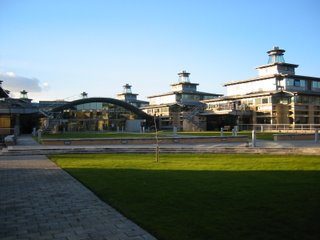 The Centre for Mathematical Sciences, pictured here, was our next stop on Saturday. Here (after lunch and playing with some problem-solving games) we heard John Barrow's lecture on "Maths and Sport." Again, it was very heartwarming to see how students of all ages were kept interested, by MATHS!
The Centre for Mathematical Sciences, pictured here, was our next stop on Saturday. Here (after lunch and playing with some problem-solving games) we heard John Barrow's lecture on "Maths and Sport." Again, it was very heartwarming to see how students of all ages were kept interested, by MATHS! This is what the Centre for Mathematical Sciences looked like during lunchtime. These kids were having a blast playing games, figuring out puzzles, building shapes, etc. It was wonderful to see.
This is what the Centre for Mathematical Sciences looked like during lunchtime. These kids were having a blast playing games, figuring out puzzles, building shapes, etc. It was wonderful to see.After our Maths and Sports lecture, we rode our bikes up to the Cavendish Laboratory (on J. J. Thomson Avenue!), home of the University of Cambridge Physics Department. The campus was FILLED with families doing hands-on physics experiments.

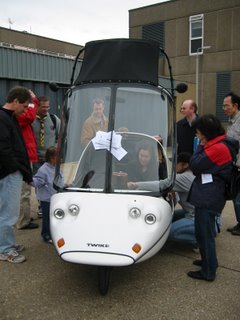 This car, called a Twike, was a big hit. It is powered partly by an electric motor and partly by pedaling. And there's no steering wheel, only a joystick. This model only costs £15,000 (about $27,000)!
This car, called a Twike, was a big hit. It is powered partly by an electric motor and partly by pedaling. And there's no steering wheel, only a joystick. This model only costs £15,000 (about $27,000)!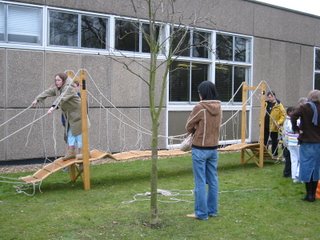 Does this crude example of a bridge look familiar to Cincinnatians? Yep. It's a suspension bridge.
Does this crude example of a bridge look familiar to Cincinnatians? Yep. It's a suspension bridge.After Cavendish Laboratory, we biked across Madingley Road to the Institute of Astronomy (founded by Sir Fred Hoyle in the early '70s). Of course, it started to rain, so the telescopes were not in operation. However, we were able to see several of them. We also attended two lectures here.
 The Northumberland telescope (ca. 1830) is housed here in this building.
The Northumberland telescope (ca. 1830) is housed here in this building.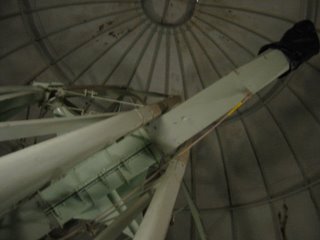 Here is a close-up of the telescope. It reminded us of a smaller version of the Lowell Observatory telescope.
Here is a close-up of the telescope. It reminded us of a smaller version of the Lowell Observatory telescope. This is the observatory. During the fall/winter, it is open to the public every Wednesday. Unfortunately for us, it is closed for spring and summer (since it's light for so long in the day, night viewing can't start unitl very late).
This is the observatory. During the fall/winter, it is open to the public every Wednesday. Unfortunately for us, it is closed for spring and summer (since it's light for so long in the day, night viewing can't start unitl very late). 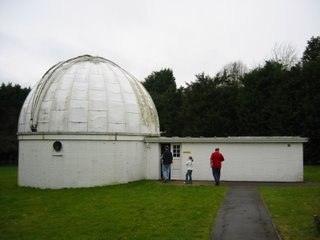 This building houses the 36-inch telescope.
This building houses the 36-inch telescope.  Here's one part of the telescope. What a contraption! Danny had to read how it works while I tried to understand by looking at the different parts. This is the base of the telescope tube, and the motor for turning it to follow the stars.
Here's one part of the telescope. What a contraption! Danny had to read how it works while I tried to understand by looking at the different parts. This is the base of the telescope tube, and the motor for turning it to follow the stars.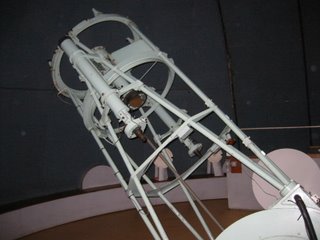 This is another part, including one of the many mirrors that reflect the starlight through the telescope.
This is another part, including one of the many mirrors that reflect the starlight through the telescope.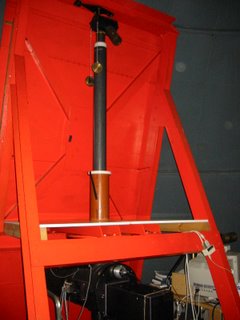 And yet another part. The final imaging takes place at the base of this orange column.
And yet another part. The final imaging takes place at the base of this orange column. This tiny building holds what is called the Three-Mirror telescope. Pictures taken from this machine, although black and white, were very high quality wide-field images of the heavens.
This tiny building holds what is called the Three-Mirror telescope. Pictures taken from this machine, although black and white, were very high quality wide-field images of the heavens.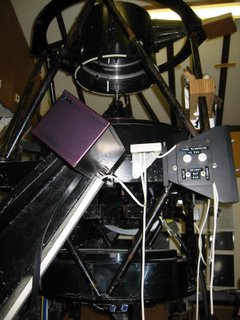 Here is what the Three-Mirror telescope actually looks like -- not pretty at all. There is a mirror housed in each of the three levels of the frame you see here, with the focal point of the image in the very center of the contraption.
Here is what the Three-Mirror telescope actually looks like -- not pretty at all. There is a mirror housed in each of the three levels of the frame you see here, with the focal point of the image in the very center of the contraption.The end of the day for us consisted of attending two astronomy talks, one on recent research on whether the fine-structure constant (that controls electromagnetic forces) has actually varied over time, and another which was a slideshow of Hubble Space Telescope images of galaxies. A great day for science!

0 Comments:
Post a Comment
<< Home